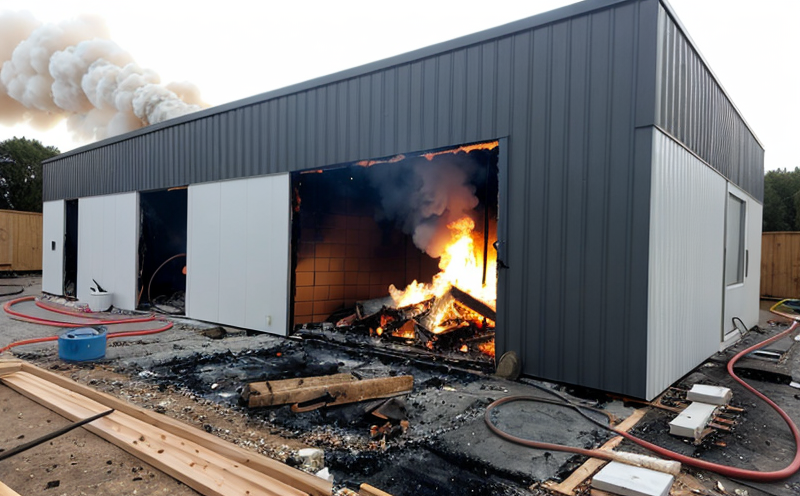Fire Performance Testing of Rockwool Insulation
The fire performance testing of Rockwool insulation is a critical component in ensuring building safety and compliance with international standards. Rockwool, being an important insulating material used widely in the construction industry, must demonstrate its resistance to ignition and flame spread under various conditions. This service focuses on evaluating the fire performance characteristics of Rockwool products through rigorous testing procedures.
Fire tests are conducted by subjecting samples to controlled environments that simulate real-world scenarios where these materials might encounter flames or heat sources. The primary goal is to assess how effectively the Rockwool insulation can resist ignition and prevent flame spread, ensuring it meets safety requirements for use in buildings.
One of the key aspects of fire performance testing involves understanding the behavior of Rockwool when exposed to temperatures above its melting point (which typically ranges between 600°C and 850°C). During these tests, we measure parameters such as flame spread index (FSI), smoke development rating (SDR), and heat release rate (HRR) to determine the material's flammability characteristics.
Another critical parameter evaluated is the time it takes for a fire source to reach a certain distance from where it was initially applied. This helps quantify the distance at which the fire would spread if unimpeded by the Rockwool insulation. Additionally, tests are performed to evaluate the melting behavior of the Rockwool sample under controlled heating conditions.
It is essential for construction professionals and quality managers to understand these aspects thoroughly because they directly impact building safety and compliance with relevant standards like ISO 834, EN 13823, ASTM E84, etc. By ensuring that Rockwool products meet stringent fire performance criteria, we contribute significantly towards enhancing public safety.
| Test Parameter | Description |
|---|---|
| Flame Spread Index (FSI) | A measure of how quickly flames spread over the surface of a material. |
| Smoke Development Rating (SDR) | An indicator of the amount of smoke produced by burning materials. |
| Heat Release Rate (HRR) | The rate at which heat is released during combustion. |
Scope and Methodology
The scope of fire performance testing for Rockwool insulation encompasses a comprehensive evaluation process aimed at assessing the material's resistance to ignition, flame spread, and heat release. This involves several stages where samples undergo controlled exposure to high temperatures and flames under specific conditions.
| Stage | Description |
|---|---|
| Sample Preparation | The Rockwool sample is cut into standard dimensions and prepared according to ASTM E84 or EN 13823. |
| Initial Inspection | All samples are visually inspected for any defects before proceeding with testing. |
| Temperature Exposure | The prepared sample is subjected to temperatures ranging from 700°C to 950°C depending on the standard being followed. |
In this stage, we carefully monitor how the Rockwool behaves under extreme heat. We observe whether it ignites easily or resists ignition entirely. If ignited, we measure how quickly flames spread across its surface and note any changes in structural integrity.
- Sample preparation ensures uniformity across all samples for accurate testing results.
- Visual inspection helps identify potential issues early on, reducing the likelihood of inconclusive test outcomes.
- The temperature exposure stage is crucial as it simulates the worst-case scenario where Rockwool might be exposed to intense heat sources in buildings.
Why Choose This Test
Choosing fire performance testing for Rockwool insulation is advantageous for several reasons. Firstly, it provides a robust assessment of the material's inherent fire resistance properties, which are vital in ensuring safe building environments. Secondly, compliance with international standards like ISO 834 and ASTM E84 can be achieved through this rigorous testing process.
- Ensures safety: By confirming that Rockwool meets stringent fire performance criteria, we safeguard against potential hazards associated with flammable materials in buildings.
- Facilitates compliance: Meeting international standards helps construction projects comply with local regulations and codes.
- Promotes trust: When clients see their chosen insulation tested and proven safe, it enhances their confidence in the product's reliability.
Competitive Advantage and Market Impact
Incorporating fire performance testing into your quality assurance process offers significant competitive advantages. Not only does it enhance safety, but it also positions your company as a leader in terms of product reliability and innovation. By ensuring that Rockwool insulation products meet the highest standards of fire performance, you can differentiate yourself from competitors who may not prioritize such stringent testing.
The market impact is substantial too. As regulations become more stringent regarding building materials' fire resistance, compliance becomes essential for all players in the construction industry. By staying ahead of these changes and demonstrating your commitment to safety, you open up new opportunities for growth and expansion into regions where higher standards are enforced.
Moreover, satisfied customers who trust that their choice of Rockwool insulation is backed by thorough testing will be more likely to recommend it to others. This positive word-of-mouth can lead to increased market share and long-term customer loyalty.





